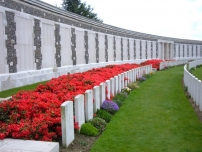| First Name: | William George | Last Name: | BUCKLAND | |
|---|---|---|---|---|
| Date of Death: | 16/08/1917 | Lived/Born In: | Harlington | |
| Rank: | Private | Unit: | Middlesex8 | |
| Memorial Site: | Tyne Cot Memorial, Belgium | |||
Current Information:Age-20 4, Belch's Cottage, Bath Road, Harlington
Third Battle of Ypres This was a campaign fought between July and November 1917 and is often referred to as the Battle of Passchendaele, a village to the north-east of Ypres which was finally captured in November. It was an attempt by the British to break out of the Ypres salient and capture the higher ground to the south and the east from which the enemy had been able to dominate the salient. It began well but two important factors weighed against them. First was the weather. The summer of 1917 turned out to be one of the the wettest on record and soon the battlefield was reduced to a morass of mud which made progress very difficult, if not impossible in places. The second was the defensive arrangements of concrete blockhouses and machine gun posts providing inter-locking fire that the Germans had constructed and which were extremely difficult and costly to counter. For 4 months this epic struggle continued by the end of which the salient had been greatly expanded in size but the vital break out had not been achieved. The Battle of Langemarck This took place between 16th-18th August, 1917 and was the second general attack of 3rd Ypres. Although it did not rain during the two days of the battle itself there had been plenty of it in the preceding days and in many places the battlefield was a quagmire. On the left of the attack in the north-west of the Ypres salient there was considerable success, especially for the French Army which attacked on the left of the British, but the attack on the Gheluvelt Plateau, due east of Ypres, met determined German resistance and the early gains were soon reversed. At 4.45am on 16th August, 1917, 169 and 167 Brigades of 56th Division attacked on the right of the battle front along a line extending from Stirling Castle on the south, northwards to Clapham Junction, along the western edge of Glencorse Wood and then along the Westhoek Ridge to the Westhoek-Zonnebeke road. . They also had a brigade from 18th Division attached to form a southern defensive flank. 167 Brigade attacked with the 8th Middlesex and 1st London battalions with 3rd London in support and 7th Middlesex in reserve. There were many enemy strongholds to overcome as they moved forward but the biggest obstacle to their progress was the state of the ground. Between the British and German trenches there was a valley at the bottom of which was a broad belt of mud, some four to five feet deep and covered with another foot of water. 8th Middlesex were forced to the left to get round it which exposed their right flank to machine-gun fire and by the time they reached Nonne Bosschen they had lost contact with 169 Brigade on their right. Enemy resistance grew stronger, it proved impossible to bring reserves and trench mortars forward and the mud prevented them from consolidating so there followed a series of withdrawals in the face of enemy counter attacks which took them back almost to their starting line. One of the many casualties suffered by 8th Middlesex during the course of this day was William Buckland. |
||||
| « Back to Search Results | ||||
| If you think any of the information shown here is incorrect, Click Here to submit your amends and comments | ||||




